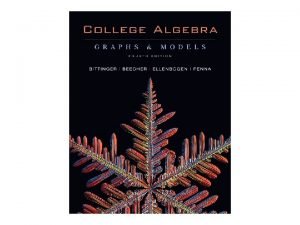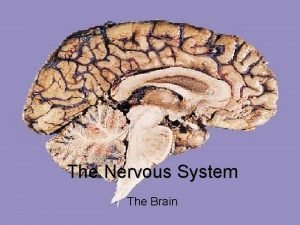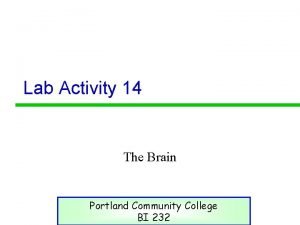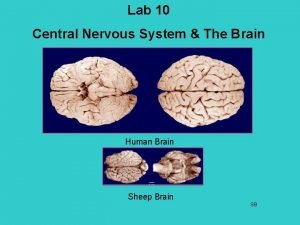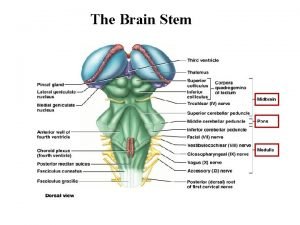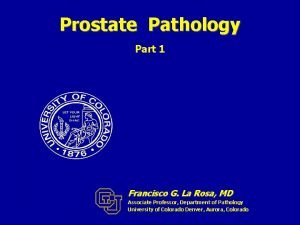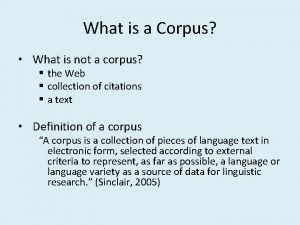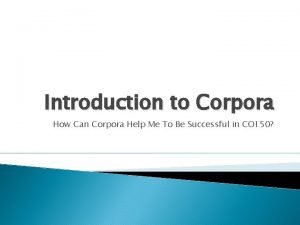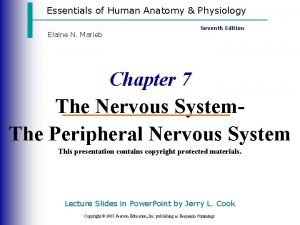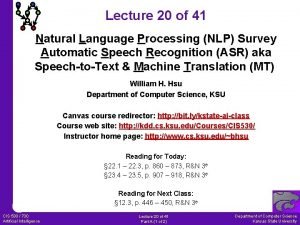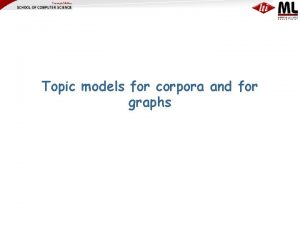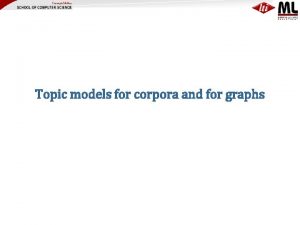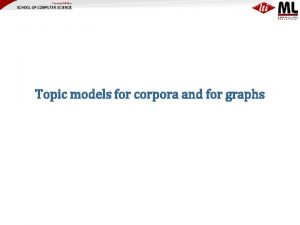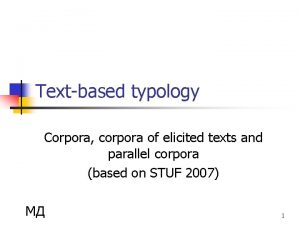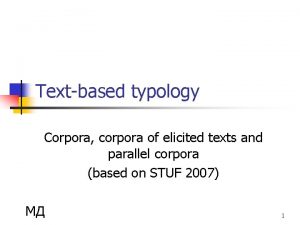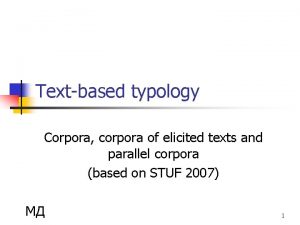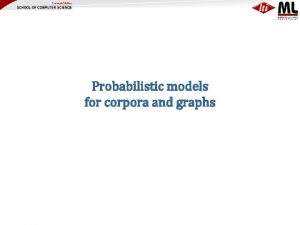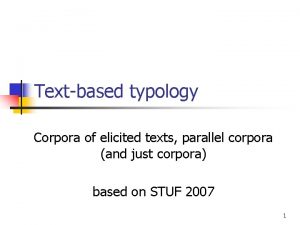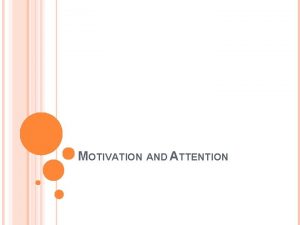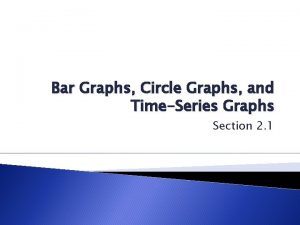Topic models for corpora and for graphs Motivation




































- Slides: 36

Topic models for corpora and for graphs

Motivation • Social graphs seem to have – some aspects of randomness • small diameter, giant connected components, . . – some structure • homophily, scale-free degree dist?

More terms • “Stochastic block model”, aka “Blockstochastic matrix”: – Draw ni nodes in block i – With probability pij, connect pairs (u, v) where u is in block i, v is in block j – Special, simple case: pii=qi, and pij=s for all i≠j • Question: can you fit this model to a graph? – find each pij and latent node block mapping

Not? football

Not? books

Outline • Stochastic block models & inference question • Review of text models – Mixture of multinomials & EM – LDA and Gibbs (or variational EM) • Block models and inference • Mixed-membership block models • Multinomial block models and inference w/ Gibbs

Review – supervised Naïve Bayes • Naïve Bayes Model: Compact representation C C W 1 W 2 W 3 …. . WN M W N M

Review – supervised Naïve Bayes • Multinomial Naïve Bayes • For each document d = 1, � , M • Generate Cd ~ Mult( | ) C • For each position n = 1, � , Nd W 1 W 2 W 3 …. . • Generate wn ~ Mult( | , Cd) WN M

Review – supervised Naïve Bayes • Multinomial naïve Bayes: Learning – Maximize the log-likelihood of observed variables w. r. t. the parameters: • Convex function: global optimum • Solution:

Review – unsupervised Naïve Bayes • Mixture model: unsupervised naïve Bayes model • Joint probability of words and classes: C Z • But classes are not visible: W N M

LDA

Review - LDA • Motivation Assumptions: 1) documents are i. i. d 2) within a document, words are i. i. d. (bag of words) • For each document d = 1, � , M • Generate d ~ D 1(…) • For each word n = 1, � , Nd • generate wn ~ D 2( | θdn) w Now pick your favorite distributions for D 1, D 2 N M

“Mixed membership” • Latent Dirichlet Allocation • For each document d = 1, � , M • Generate d ~ Dir( | ) • For each position n = 1, � , Nd z • generate zn ~ Mult( | d) • generate wn ~ Mult( | zn) w N M K

• vs Naïve Bayes… z w N M K

• LDA’s view of a document

• LDA topics

Review - LDA • Latent Dirichlet Allocation – Parameter learning: • Variational EM – Numerical approximation using lower-bounds – Results in biased solutions – Convergence has numerical guarantees • Gibbs Sampling – Stochastic simulation – unbiased solutions – Stochastic convergence

Review - LDA • Gibbs sampling – Applicable when joint distribution is hard to evaluate but conditional distribution is known – Sequence of samples comprises a Markov Chain – Stationary distribution of the chain is the joint distribution Key capability: estimate distribution of one latent variables given the other latent variables and observed variables.

Why does Gibbs sampling work? • What’s the fixed point? – Stationary distribution of the chain is the joint distribution • When will it converge (in the limit)? – Graph defined by the chain is connected • How long will it take to converge? – Depends on second eigenvector of that graph


Called “collapsed Gibbs sampling” since you’ve marginalized away some variables Fr: Parameter estimation for text analysis - Gregor Heinrich

Review - LDA “Mixed membership” • Latent Dirichlet Allocation • Randomly initialize each zm, n • Repeat for t=1, …. • For each doc m, word n z • Find Pr(zmn=k|other z’s) • Sample zmn according to that distr. w N M

Outline • Stochastic block models & inference question • Review of text models – Mixture of multinomials & EM – LDA and Gibbs (or variational EM) • • Block models and inference Mixed-membership block models Multinomial block models and inference w/ Gibbs Beastiary of other probabilistic graph models – Latent-space models, exchangeable graphs, p 1, ERGM

Review - LDA • Motivation Assumptions: 1) documents are i. i. d 2) within a document, words are i. i. d. (bag of words) • For each document d = 1, � , M • Generate d ~ D 1(…) • For each word n = 1, � , Nd • generate wn ~ D 2( | θdn) w Docs and words are exchangeable. N M

Stochastic Block models: assume 1) nodes w/in a block z and 2) edges between blocks zp, zq are exchangeable zp zp p zq apq N N 2

Stochastic Block models: assume 1) nodes w/in a block z and 2) edges between blocks zp, zq are exchangeable Gibbs sampling: • Randomly initialize zp for each node p. • For t = 1… zp zp • For each node p zq • Compute zp given other z’s p apq N • Sample zp N 2 See: Snijders & Nowicki, 1997, Estimation and Prediction for Stochastic Blockmodels for Groups with Latent Graph Structure

Mixed Membership Stochastic Block models p p q zp. p z. q apq N N 2 Airoldi et al, JMLR 2008

Parkkinen et al paper

Another mixed membership block model

Another mixed membership block model z=(zi, zj) is a pair of block ids nz = #pairs z qz 1, i = #links to i from block z 1 qz 1, . = #outlinks in block z 1 δ = indicator for diagonal M = #nodes

Another mixed membership block model

Experiments + lots of synthetic data Balasubramanyan, Lin, Cohen, NIPS w/s 2010



Experiments Balasubramanyan, Lin, Cohen, NIPS w/s 2010

Experiments Balasubramanyan, Lin, Cohen, NIPS w/s 2010
 State graphs in software testing
State graphs in software testing Graphs that enlighten and graphs that deceive
Graphs that enlighten and graphs that deceive Chapter 1 graphs functions and models answers
Chapter 1 graphs functions and models answers Comparing distance/time graphs to speed/time graphs
Comparing distance/time graphs to speed/time graphs End behavior chart
End behavior chart Reticular activating system
Reticular activating system Activity 1
Activity 1 Dura mater
Dura mater Vision dichromatique cheval
Vision dichromatique cheval Types of corpora
Types of corpora Corpora corpus
Corpora corpus Midbrain pons medulla
Midbrain pons medulla Corpora quadrigemina pronunciation
Corpora quadrigemina pronunciation Nodular hyperplasia
Nodular hyperplasia Corpora aranacea
Corpora aranacea Corpora
Corpora Help
Help Stephen hawking
Stephen hawking Lead paragraph example
Lead paragraph example Narrowed down topic
Narrowed down topic Semi modals
Semi modals Models of motivation in indian thought
Models of motivation in indian thought Topic models
Topic models Euler circuit
Euler circuit Describing visual data
Describing visual data Kontinuitetshantering i praktiken
Kontinuitetshantering i praktiken Novell typiska drag
Novell typiska drag Nationell inriktning för artificiell intelligens
Nationell inriktning för artificiell intelligens Vad står k.r.å.k.a.n för
Vad står k.r.å.k.a.n för Varför kallas perioden 1918-1939 för mellankrigstiden
Varför kallas perioden 1918-1939 för mellankrigstiden En lathund för arbete med kontinuitetshantering
En lathund för arbete med kontinuitetshantering Personalliggare bygg undantag
Personalliggare bygg undantag Tidböcker
Tidböcker A gastrica
A gastrica Förklara densitet för barn
Förklara densitet för barn Datorkunskap för nybörjare
Datorkunskap för nybörjare Stig kerman
Stig kerman


